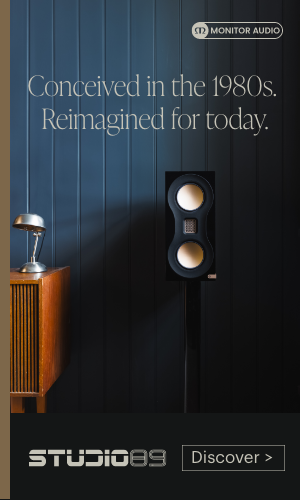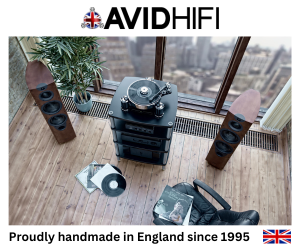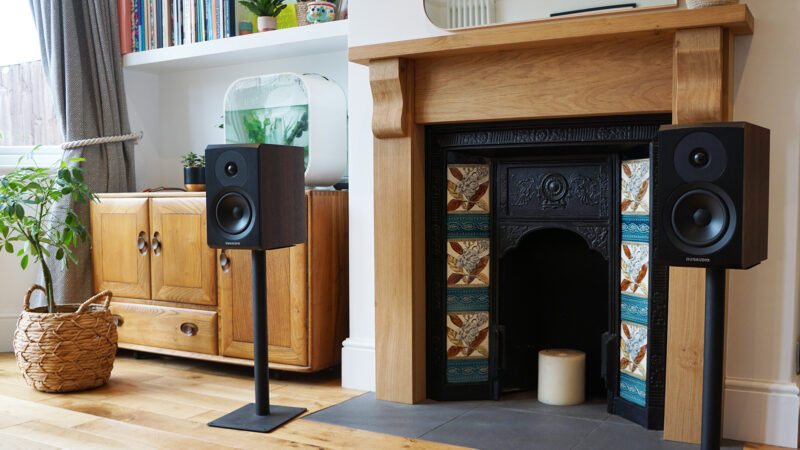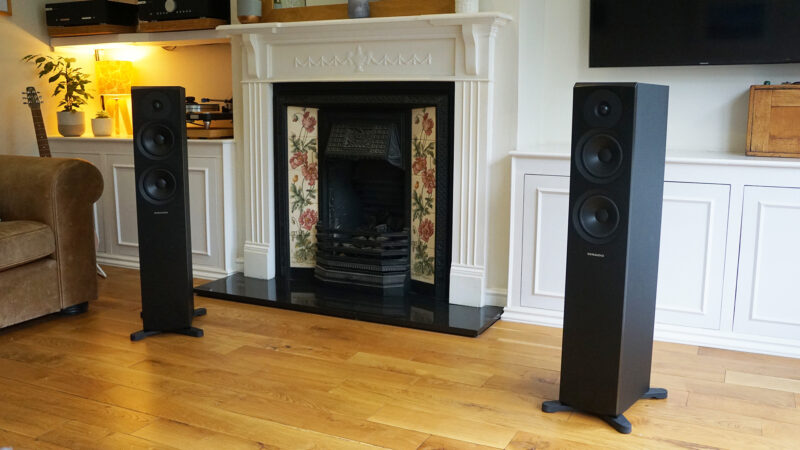Launching an entry level range in any industry is always a tricky business. If you make too many compromises in an effort to get prices down you risk damaging your brand’s reputation, but if you offer too much, then you end up competing with yourself by undercutting your more upmarket stock.
As we found with our 10 (£630) and 30 (£1,300) model reviews last year, Dynaudio has expertly walked this line with the Emit range, offering great value hardware in cabinets that are well finished but with obvious upgrade paths as your system evolves.
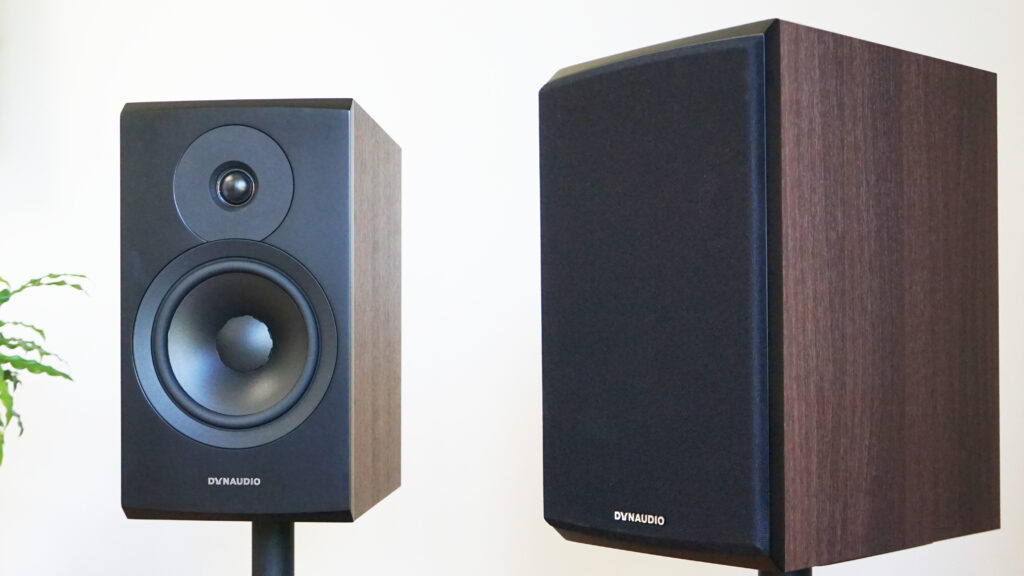
Classic lines with nicely curved front baffle edges and magnetically attached grille covers make these a cut above budget boxes
And when canvassing opinion of which model to review for 2022 from the Audiograde community (with our sights set on the Special Forty and Heritage models), the answer came back loud and clear to not overlook the Emit 20 as the mid-model in the range, because of what it offers at its £825 price in these increasingly challenging times.
Made to measure
While the Emit 20 shares much of its DNA with its bookshelf 10 and floorstanding 30 siblings, what it’s not is simply the same hardware in a different sized box. Sure it includes a matching 28mm Cerotar soft dome tweeter with Hexis (to aid high frequency dispersion), 18mm MDF cabinet walls and a first order tweeter with second order woofer crossover topology, but what you also get is a custom sized and incorporated 18cm mid/bass woofer that’s lifted from the range topping Emit 50 three-way (£1,750). This makes the Emit 20 wider than both the 10 and 30 models at 205mm (compared to their slim 170mm profile) contributing to its internal cabinet volume of 15.85L (the Emit 10 is 7.73L and Emit 30is 29.66L), while presenting a speaker that looks more traditionally proportioned.
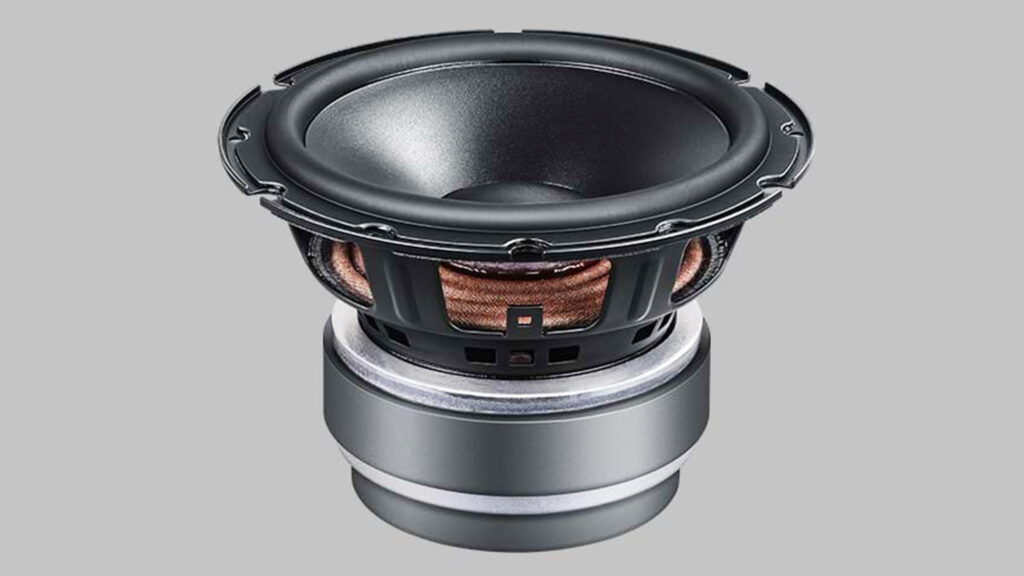
Emit 20’s mid/bass driver uses a lightweight long-throw 18cm cone that’s made in-house
The Emit 20’s mid/bass driver is formed from Dynaudio’s proprietary Magnesium Silicate Polymer (MSP) material in one piece, with trademark venting around its central dust-cap. Its aluminium voice-coil is copper coated and wound onto a two-layer glass-fibre former that sits ahead of twin stacked ferrite magnets.
Read more about the Emit range’s design in our exclusive interview with Dynaudio Senior Acoustics Engineer Stephen Entwistle.

Rear bass port and single speaker terminals are nicely finished
Like the rest of the range, while the cabinet is vinyl wrapped as opposed to real wood veneer, the quality and matt finish is understatedly convincing, right down to the textured grain.
Rear connections are limited to a single set of multi-way speaker terminals that sit below a double flared rear bass port behind the tweeter. There’s also an optional foam bung included to aid fine-tuning of the speaker’s low notes, especially with the port firing close to a rear wall.

Available in black, white or walnut, the vinyl finish gives nothing away. Deep (324cm) cabinet ensures they deliver plenty of weight and scale
Performance
Like a speech at the Oscars, it’s only right to kick off by thanking our supporters as, in a word, you were right. The Emit 20s are worth every ounce of evaluation and have brought days of delight in the process. Installed and thoroughly run in within my 7×4.5m listening room and firing from the narrower axis, driven by a Musical Fidelity M6 pre/power amp combination, these speakers offer a performance that shows how well balanced a package the are.
With Little Dragon’s Paris from their Nabuma Rubberband album spinning on my VPI Scout 21 deck, the Dyns convey the music with enough energy to start a party. Nailing this track’s pace is a measure of any speaker with its start/stop upper bass notes that leave no time for contemplation, the Emits clearly sense this and put their foot to the floor with a sense of command that brings real authority to the notes without labouring them.
What also comes across on this track and during my time spent with these speakers is the soundstage they convey. It’s wider by some margin than that of the Emit 10s (as you’d expect given their larger footprint) but the more noticeable dimension is the depth of the soundstage, which is substantially deeper and denser in texture than that of the smaller Emit 10, and most rival standmounts in this price bracket for that matter.
In tribute
Serving them a richer digital diet underlines this further with a 24-bit/96kHz file of Pink Floyd’s Coming Back To Life from The Division Bell streamed over Qobuz via my Primare NP 30 player. The keyboards and percussion extend from a good few feet behind my wall allowing plenty of space for the guitars to fill the mix with realism.
As is the Dynaudio signature, even at this modest price sibilance is kept to a minimum, with smoothness triumphing over brightness, making for a less fatiguing long term listening. Some speakers may seem more eager out of the traps than the Dyns which are mature beasts in some respects and don’t crave attention, preferring a more refined presentation with just the right amount of damping.
I’m penning this to the sad news of Depeche Mode’s founding keyboardist Andy Fletcher’s passing, which has had me revisiting the band’s back catalogue in tribute. An ALAC 16/44 rip of Enjoy The Silence gets the Emit 20s in their element, allowing them to play their ace card of seamless driver integration in the midrange. The synthesiser notes are full of presence and during the sections when the levels temporarily drop, the inky black silences are instantly recognisable as pure Dynaudio trademarks.
Sure the Emit 20s role off short of their 30 brethren and in ultimate terms don’t have the same sense of scale, but in midsize rooms where space and bass tuning can be more frustrating than rewarding, the Emit 20 makes a compelling case for itself.
In summary
Having reviewed and lived with most of the new Emit models, the 20 is arguably the sweet spot in the range. It strikes an enviable balance of scale, dynamics, pace and seamless integration in a package that is so easy to live with. Dynaudio has really delivered with the Emit range on price without overly compromising, and the 20 model perhaps illustrates this the most.



